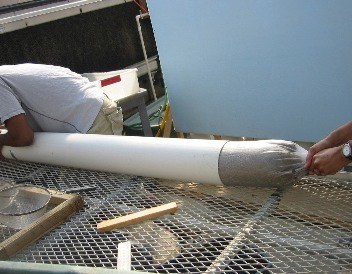
Lifting a cylinder pre-harvesting
The process of harvest is a rather demanding task that can take about a day for a team of two people for 12 cylinders. If you are working with replications we suggest that you stagger them so you do not have to do all your harvest the same day.
First, two people can lift the cylinders from the base and bring them to a flat surface as a table or greenhouse bench.
Once you have your cylinder resting horizontally then first remove about 10 cm (3 inches) of media from the bottom of the cylinder. Be careful when you remove the media as the roots could be in the bottom, depending on the time of your experiment and the plants you are using. In our experience these cylinders are tall enough to prevent corn plants to reach the bottom for at least four weeks.
Twisting the plastic sleeve you will get a good grip, be careful before you pull the bag as it could cut suddenly at the resting line of the PVC. Now with another person holding the PVC you can pull the sleeve out, this should not be a very demanding thing to do, if you feel that the bag is completely stuck is possible that your bag got wet.

Once the bag is out you can start looking at the root distribution and recording the depth of the root, or if this has moved by the sides or inside the soil column. In our experience about a third of the time you can find deep roots growing between the plastic and the media, but most of the roots actually grow inside the soil column, away from the border.

You can harvest the root now. Cut the plastic sleeve slowly and using a hose with a shower type nozzle start to wash away the media starting from the bottom. Once you find the roots hold them carefully while you keep washing the media away. Keep opening the sleeve as you go upwards harvesting the roots.

If you are successful you will end with a clean root in about 15 minutes. In our experience once you are familiar with this method you should not lose any significant fraction of roots.
This is an example of a root harvested with this method.

References
Kashiwagi, J; Krishnamurthy, L; Upadhyaya, HD; Krishna, H; Chandra, S; Vadez, V; Serraj, R. Genetic variability of drought-avoidance root traits in the mini-core germplasm collection of chickpea (Cicer arietinum L.). EUPHYTICA, 146 (3): 213-222 DEC 2005

